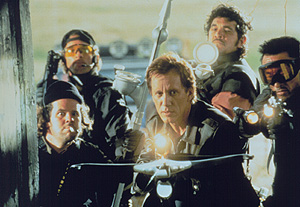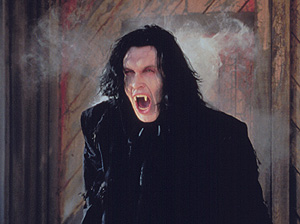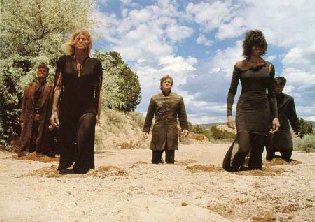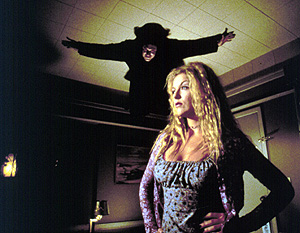John Carpenter's Vampires
 
John Carpenter's Vampires is bloody awful. That's distressing, because it has a lot going for it. It stars James Woods, and he's always fun to watch. It also has Sheryl "wrapped in plastic" Lee, and we're all for that. Plus, it's directed by John Carpenter, who has made some of our favorite scary movies. But Carpenter seems to be way off form here, so much so that it seems that nothing can save the film. The plot of Vampires is that the Catholic Church has been secretly financing groups of vampire slayers* to go around and kill the pesky beasts. James Woods plays Jack Crow, the leader of one of these crews. As the film opens, Jack and his team of slayers, who are basically the same bunch of people who were shot into space in Armageddon, take out a vampire nest in New Mexico, but they miss the "master," a super vampire named Valek. Later that night, as the slayers overdose on cheap alcohol and cheap hookers at a cheap hotel, Valek drops by and puts a serious hurting on everyone present. Crow, his partner Montoya (Daniel Baldwin), and one hooker (Lee) manage to escape, but the hooker has been bitten. Crow plans on using the psychic link that results from a vamp bite to track Valek down. Valek, true to form, has some master plan or another which will give him the ability to survive in the sunlight, thus giving Crow some extra incentive to find him.
Scientific vampire movies like to treat vampirism as a disease. Scientific vampires aren't affected by things like crosses or holy water, and if they can be hurt by garlic there is a scientific reason for it. They're usually not evil per se, but more likely driven mad by the need for blood. Those movies that do explore the scientific side of vampires usually botch their explanations (these are screenwriters, not scientists), but tend to come up with nifty new ways to kill vampires, too. For example, Blade used garlic injections to stave off the main character's own imminent vampirism, and made use of sun lamps to kill the critters at night.
One of the most worrying things about Vampires is the film's misogyny. The film dwells much more on the stabbings and wounding of female vampires, not to mention the way that the camera lingers on Sheryl Lee every time she is tied up, which is often. The most troubling example, though, is the relationship between Montoya and Katrina (Lee's character). Because she will soon turn into a vampire, Crow treats her as a vampire. Montoya, on the other hand, falls in love with her. But for a guy who says he loves this particular woman, he sure does hit her a lot.
Vampires owes much of its existence to the Tarantino/Rodriguez brainchild called From Dusk Till Dawn. This more recent film apes many of Dusk's details, from the Southwestern setting to the honky-tonk soundtrack (composed by Carpenter himself, as usual) and leather-clad protagonists. Granted, the vampires in Carpenter's movie are inspired more by Anne Rice than by the Tom Savini-esque monsters who appeared in Dusk, but it's obvious that Vampires is trying to capitalize on the popularity of Dusk, which is already something of a cult classic. Unfortunately, Vampires doesn't take to heart From Dusk Till Dawn's central moviemaking lesson: a movie doesn't have to be about the end of the world in order to be exciting and entertaining. Dusk gave us the story of a small band of humans just trying to survive the night in a vampire bar, but Vampires tries to support the more cumbersome tale of a vampire hunter on a quest to stop the world's first vampire from becoming a daywalker. Despite a few clever Carpenter touches (witness the priest's metamorphosis into MacReady from Carpenter's The Thing) and some beautifully stylish cinematography, there's just too much crammed into these 107 minutes, most of it unprintable.
 Review date: 11/4/98 
This review is © copyright 1998 Chris Holland & Scott Hamilton. Blah blah blah. Please don't claim that it's yours blah blah, but feel free to e-mail it to friends, or better yet, send them the URL. To reproduce this review in another form, please contact us at guys@stomptokyo.com. Blah blah blah blah.
|



